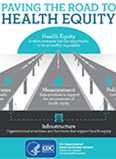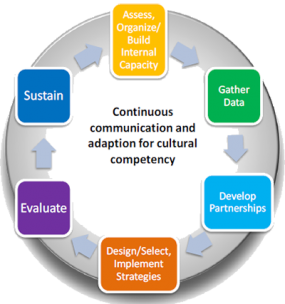Spotlight

Strategies for Reducing Health Disparities — Selected CDC-Sponsored Interventions, United States, 2016

The 2016 supplement, Strategies for Reducing Health Disparities — Selected CDC-Sponsored Interventions, United States, 2016, includes interventions to address disparities by race and ethnicity, socioeconomic status, geographic location, disability, and/or sexual orientation across a range of conditions, some of which address social and structural determinants of health. For example, three interventions are highlighted in an article describing evidenced-based approaches that address policies and structural factors in high risk communities and have the potential to reduce violence. This supplement builds on earlier works including the 2011 CDC Health Disparities and Inequalities Report (CHDIR) 2011, the first CDC Morbidity and Mortality Weekly Report (MMWR) to assess disparities across a wide range of diseases, behavioral risk factors, environmental exposures, social determinants, and health-care access and a subsequent release in 2013, providing updated data and 10 new topics.

Advancing the Science and Practice of Health Equity
Learn more about cross-cutting efforts that advance the science and practice of health equity in a special supplement to the Journal of Public Health Management & Practice. The supplement captures lessons related to data and measurement, program elements and implementation, policies to support health equity, and the infrastructure needed to ensure health equity is integrated across programs. It offers examples from state health departments and insightful commentaries and editorials that raise questions, issues, and opportunities to enhance impact.
Health Equity in Tobacco Prevention and Control

Learn how comprehensive tobacco control programs can work to achieve Health Equity in Tobacco Prevention and Control. This user guide focuses on how comprehensive tobacco control programs can work to achieve health equity in tobacco prevention and control. It offers tobacco control program staff and partners information on how to work toward achieving health equity when planning, implementing, and enforcing tobacco control policies.
Spotlight: Health Equity Resource Toolkit for state practitioners to address obesity disparities and improve heart health
Obesity-related conditions include heart disease, stroke, type 2 diabetes, and certain types of cancer – some of the leading causes of preventable death. Non-Hispanic blacks have the highest age-adjusted rates of obesity (48.1%) followed by Hispanics (42.5%), non-Hispanic whites (34.5%), and non-Hispanic Asians (11.7%). The Health Equity Resource Toolkit helps state health departments and partners work with communities to reduce obesity in populations experiencing health disparities. It helps users learn how changes in policy, health systems, and environment can reduce obesity disparities and achieve health equity.
Health Equity in Obesity Prevention Planning Process

Figure 4: The Health Equity in Obesity Prevention Planning Process, a general planning process developed from multiple planning processes and models for this toolkit.
Spotlight: Community-based and Participatory Strategies to Reduce Disparities: Racial and Ethnic Approaches to Community Health (REACH)

Since 1999, the REACH program has used tailored, community-based and participatory approaches to reduce disparities and improve health among racial and ethnic populations experiencing high burdens of chronic disease. The 49 REACH awardees plan and carry out local, culturally-appropriate programs to reduce smoking, increase physical activity and good nutrition, and reduce the complications associated with chronic diseases. Examples of strategies include: protecting people from secondhand smoke exposure and giving low-income smokers access to reduced-cost, evidence-based cessation treatments; and increasing physical activity opportunities by working with partners to decrease out-of-pocket costs for using community recreation facilities.
Learn more about REACH programs and awardee activities with this Fact Sheet.
- Page last reviewed: July 27, 2017
- Page last updated: July 27, 2017
- Content source:


 ShareCompartir
ShareCompartir